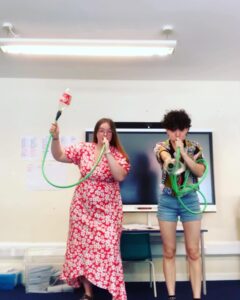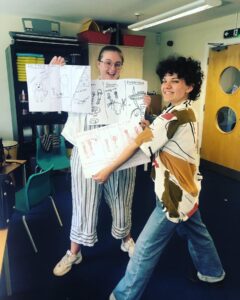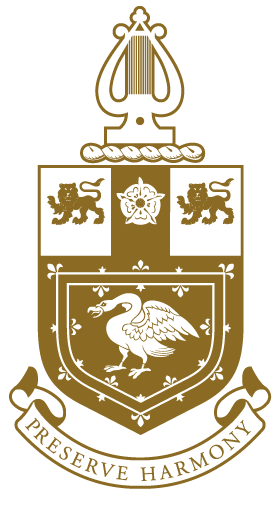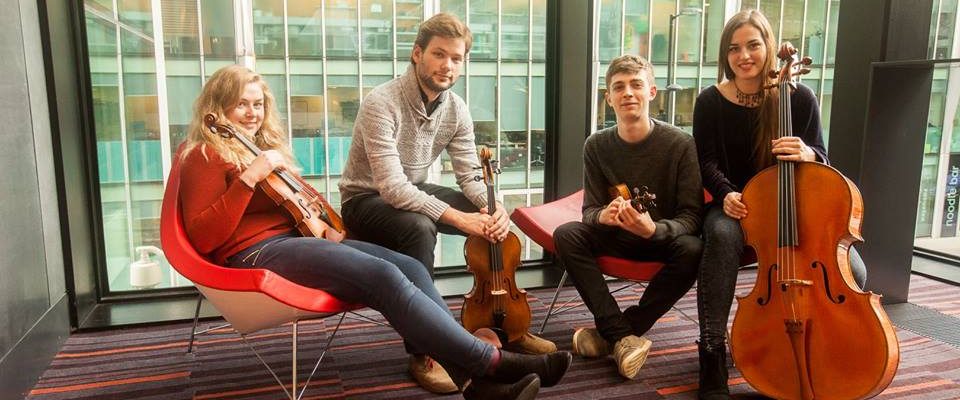Music in Schools: St Alban’s Primary Project (Camden 2022)
Young Artist Eliza Talman of the award-winning Solis Trio has been sharing the joy of music with pupils through our Music in Schools partnerships. Funded by The Musicians’ Company Future of Music Fund, The Musicians’ Company, and private donors, the partnerships aim to help reduce disadvantage gaps to music access in London schools. We caught up with Eliza to discuss her recent project at St Alban’s primary school in Camden.
Tell us a bit about the St Alban’s project!
Meggie, a fellow Young Artist, and I did four sessions with year twos, and five with year threes. Meggie is also the trombonist in our trio, which made it so much fun! We were joined by Musicians’ Company volunteer, Richard Sheldon, who was wonderful and very hands on. He even brought in his bassoon to do duets when one of us couldn’t make it! Our only objective initially was to get the young people to experience and create music, so with each session lasting an hour or half an hour (we had to have two year 3 groups), we usually split the session up with lots of games. While we didn’t have any SEND pupils in year two, one year three pupil had an assistant the whole time and it was great to be able to give them some one-to-one.
Was this your first school project as a Musicians’ Company Young Artist?
Yes, it was my first school project, and I was quite nervous before we started – but as soon as we got stuck in it was all much easier. My main fear was that we would run out of material for the lesson (which did actually happen in the first class because I panicked and sped through our plan). Since then, I’ve got much better at taking my time and NOT TALKING SO MUCH! I’ve also learnt how to properly plan a lesson and adapt with the materials that I’m given in the room.
Did you have a theme for the project?
We didn’t have a theme, but we started talking about the orchestra and playing games where everyone had to mime the instruments we shouted out. In the year three class we had a running theme of emotions, and we created a story using three emotions that we drew and told the rest of the class, before creating different music to each emotion. I talk more about that in a later question!

Had the pupils tried brass instruments before?
None of the pupils had played brass before – usually you have to wait until your front two adult teeth have grown. That said, they almost all made a note on our hosepipe instruments and always wanted us to bring them back so that they could have another go!
What’s with the Coca-Cola bottle?
Haha, good question! The Coca-Cola bottle is actually a highly sophisticated natural trumpet, and the Fanta is a sackbut… To elaborate, we cut out hosepipe to be the length of all the tubing in a trumpet and trombone (if the instruments were unwound and pulled into a line, they would be the same lengths as the hose) and the bottles act as bells – which is what helps project the sound. We brought in as many spare mouthpieces, sterilised them, and got the pupils to have a go playing them. They work really well because the sound is so direct out of the bottle-bell, and they can understand how our instruments work much easier.
How did you help the children link music to emotions?
We tried to simplify music’s relations to mood, with slow and low often equating to sadness, and loud, high, and fast creating excitement. Something more jittery, fast and ‘unsteady’ would be nervous. The easiest way to start it off was by playing music to them and letting them tell us how it made them feel. Often slow tunes would make them feel tired, sad, lonely, and faster ones would make them excited or happy.
Essentially there were no wrong answers when anyone would give us their opinion, but we tended to pander to the more obvious interpretations just for the ease of the time limit. With the creation of the pieces, each group did it their own completely different way. Some played around with solos, some split it up with their instruments: glockenspiels, kazoos (!), drums and voice, and some played all the way through and had another pupil conducting each section.

What did the pupils learn by the end of the project?
The teachers were very enthusiastic about the project, and many of the pupils told us they wanted to learn trumpet or trombone! We did work on rhythm and pitch before the emotions were involved so their understanding of composition was well structured and by the last session their ability to play together was much stronger.
Any standout moments?
One of my favorite lessons, and most challenging was when Meggie couldn’t make a session, so Richard brought in straws with the ends cut diagonally so they could be used like bassoon reeds. Every pupil got one and it was carnage for about half an hour – which was a very good lesson for me in the order in which to give out noisy instruments. The same happened with kazoos. Meggie and I bought a load for both classes and the year twos were so chilled and obedient that whenever we said to be quiet, they just would! The same was not applicable for the year threes and it was another very loud hour of kazoos and drums.
Would you do a participation project again?!
Yes absolutely! I’ve since co-led a project at Swiss Cottage with a saxophonist and am currently leading in a project at Moreland School with a wonderful singer Jack Holton. It’s such a great opportunity to play and work with new musicians and to adapt to their styles of teaching, as well as to learn how to lead and be utterly versatile in situ. I think that learning on the job is undoubtedly the quickest way to learn!
Interview by Suzy Willmott
Suzy is freelance copywriter who works with the Musicians’ Company





